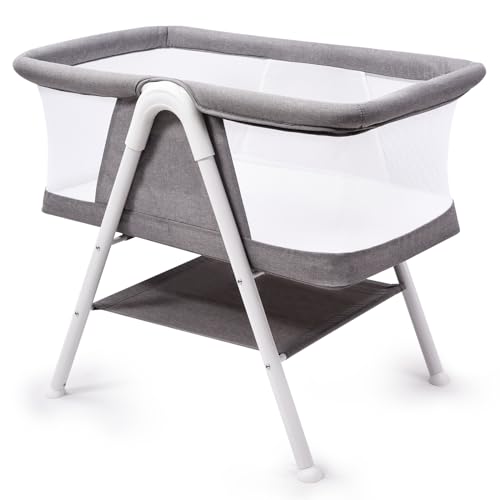
Recommended Cribs
FollowOverview
-
Founded Date 7 février 2003
-
Sectors Artificial Intelligence
-
Posted Jobs 0
-
Viewed 39
Company Description
Buy A Cot: 11 Things You’re Forgetting To Do
Buying a Cot: A Comprehensive Guide for New Parents
Bringing a new child into the world is an awesome journey, but it features a plethora of obligations. One of the very first purchases brand-new moms and dads face is a cot, which is vital for guaranteeing their baby’s security and comfort during sleep. This guide serves to offer information on how to pick the very Best Cots For Newborns cot matched for a newborn’s needs, the different types available, and crucial safety features to consider.
Why a Cot is Essential for Your Baby
A cot offers a dedicated sleeping space for babies, which is vital for their development and development. Not only does it keep the baby safe and secure, however it likewise promotes healthy sleep habits.
Key reasons to buy a cot consist of:
- Safety: Cots are created with safety in mind, featuring sturdy construction and safety requirements that secure babies from mishaps.
- Convenience: Most cots include bed mattress developed for infants, supplying ideal assistance for a baby’s developing body.
- Convenience: Cots can ease the burden of nighttime feeding and diaper changes, as they are developed to be quickly accessible.
Types of Cots
When aiming to buy a cot, brand-new parents will find a range of types tailored to various needs and choices. Below is a detailed list of the different types of cots readily available in the market:

-
Standard Cot:
- A classic option, generally rectangle-shaped and built to accommodate a baby up till they are around 2 to three years old.
-
Convertible Cot:
- This type can be changed into a toddler bed or even a full-size bed, using longevity and value for cash.
-
Travel Cot:
- Portable and lightweight, these are perfect for families who travel frequently or need a temporary sleep option. They can be quickly established and removed.
-
Moses Basket:
- A small, portable basket lined with soft materials, appropriate for babies. Ideal for keeping the baby close at hand during the early months.
-
Cradle:
- Rocking or stationary, cradles supply a soothing motion to relieve babies to sleep and can be a visual addition to a nursery.
-
Co-Sleeper:
- Also referred to as a sidecar crib, this connects to the moms and dad’s bed enabling simple access to the baby throughout the night while preserving a separate sleeping space.
| Type of Cot | Appropriate Age | Key Feature |
|---|---|---|
| Requirement Cot | Approximately 2-3 years | Stable and long lasting |
| Convertible Cot | Up to 6+ years | Grows with the kid |
| Travel Cot | Birth to 3 years | Lightweight and portable |
| Moses Basket | Newborn (approximately 3-4 months) | Small and quickly carried |
| Cradle | Newborn (approximately 6 months) | Calming rocking motion |
| Co-Sleeper | Newborn (approximately 6 months) | Close distance to parents |
Safety Features to Look For
When purchasing a cot, security must be a vital concern. Security requirements differ by country, but there are universal functions that all cots must have:
-
Sturdy Construction: Ensure the cot is made from strong materials that can stand up to use with time.
-
Adjustable Mattress Height: Many cots come with adjustable base levels, permitting you to reduce the mattress as the baby grows.
-
Non-Toxic Materials: Verify that the paint, finishes, and fabrics utilized in the cot are devoid of harmful chemicals.
-
Slat Spacing: Make sure that the range in between the slats does not go beyond 6 centimeters (2.4 inches) to prevent the baby’s head from getting caught.
-
Stable Base: The cot must have a large base to avoid tipping, particularly when the baby begins standing and bouncing.
-
Compliance with Safety Standards: Check for certification stickers or security requirements particular to your country.
Frequently Asked Questions (Frequently Asked Questions)
1. What age can my baby start oversleeping a cot?
Most children can transition to a cot from a bassinet or Moses basket when they have to do with 3-4 months old, or when they begin to push themselves up.
2. How do I ensure the cot is safe for my baby?
Always inspect that the cot adheres to security policies in your location. Check for any loose parts, sharp edges, or areas that could posture a risk.
3. What kind of mattress is best for a cot?
A firm, flat mattress is ideal given that it supplies the best assistance for your baby’s body, lowering the risk of suffocation and promoting safe sleep.
4. The length of time can the cot be utilized?
A standard cot can usually be used up until a kid is about 2-3 years of ages, while convertible cots can extend this use as they can be transformed into bigger beds.
5. Is it safe for my baby to sleep in the co-sleeper?
Yes, as long as the co-sleeper meets safety guidelines and is firmly connected to the parent’s bed, it provides a safe sleeping environment.
The process of picking the best cot can be frustrating for new moms and dads, provided the increasing plethora of choices offered in the market. Nevertheless, by comprehending the different kinds of cots and focusing on necessary security features, parents can make an informed choice that will ensure their baby’s comfort and safety.
As the baby grows, the cot can likewise become a cherished safe sanctuary, supplying relaxing sleep and a sanctuary that fosters bonding between parent and kid. Ultimately, the right cot is more than just a furniture piece; it’s an important financial investment in your baby’s health and wellness.






































